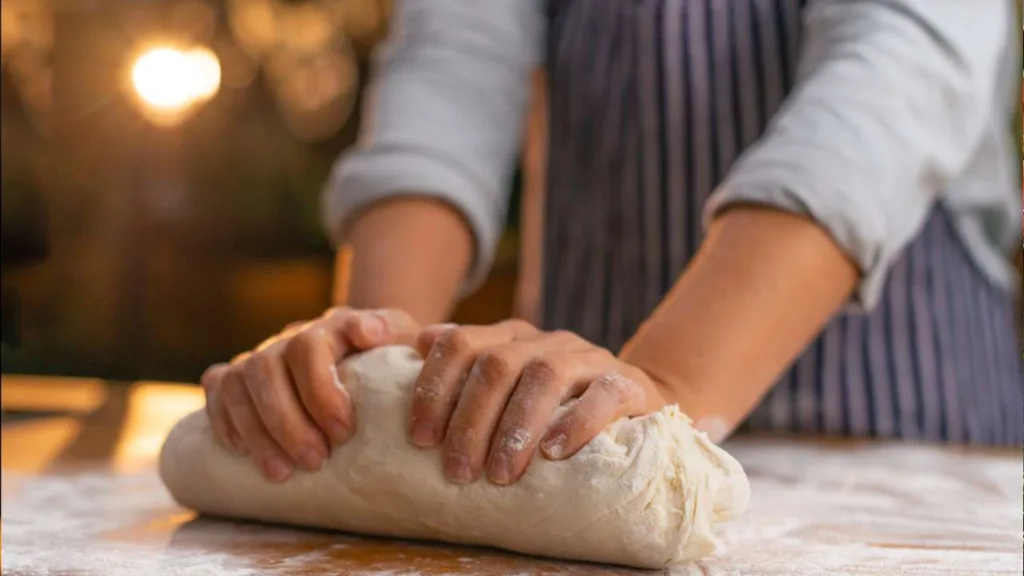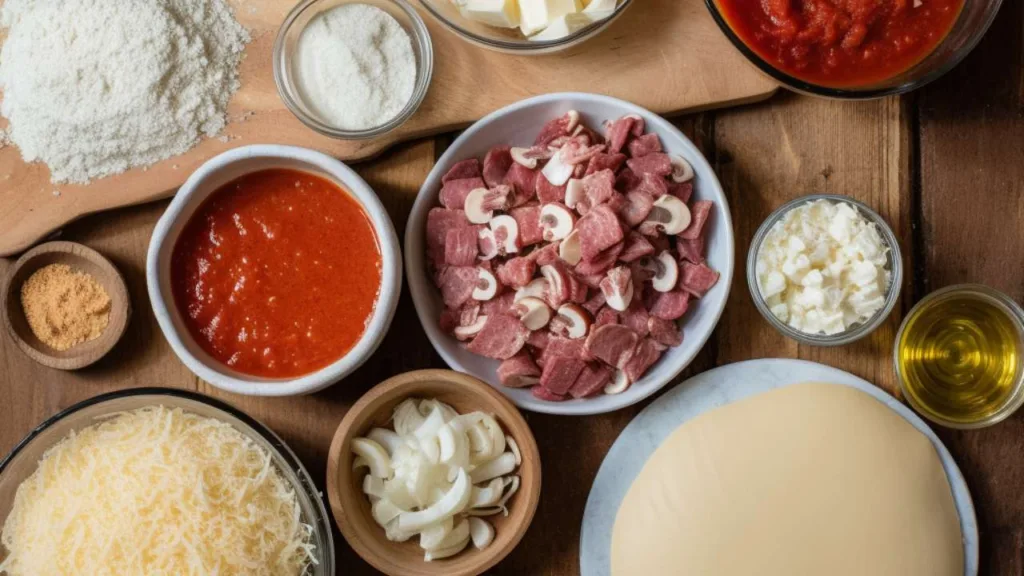Real Taste Gluten-Free Pizza Recipe
- Luis
- Last Updated on October 31, 2023
Table of Contents
If you absolutely love pizza but pizza doesn’t always love you then this gluten-free pizza recipe is the one for you. By making this recipe, you will be able to enjoy pizza on your own terms without needing to worry about any undesirable outcomes.
This is a basic gluten-free pizza recipe and consists of a gluten-free flour blend, instant yeast, xanthan gum, and most importantly, no gluten! This recipe will very quickly become your favorite and this gluten-free pizza crust is definitely crispy.
This gf pizza dough recipe can be made in a domestic oven and it will still come out perfect even without the use of a pizza oven. This will surely become a regular in your rotation of gluten-free recipes and it will take your gluten-free baking to the next level!
-
Serves
2 People
-
Cooking Time
30 Minutes
-
Preparation Time
1-2 hours
-
Difficulty
Line Cook's Leap
Gluten-free pizza, as the name suggests, does not contain any gluten. It simply contains gluten-free flour that is made without gluten and is meant to replace all-purpose flour. The flour is usually made of different types of grains, nuts, and seeds.
One of the most notable differences between gluten-free pizza and regular pizza is that gluten-free pizza crust does not rise like normal dough but you are still able to produce a crispy gluten-free crust.
Why this gluten-free pizza recipe works
This gluten-free pizza dough recipe works because it is a basic recipe that can be altered to your taste and the availability of the products within your home.
You can change the type of flour that you are using which means that you can use whatever you have on hand instead of going shopping which saves time and makes this recipe very handy.
This recipe can also just simply be made in a stand mixer which means that there is no kneading needed from your side. You are also able to freeze this recipe for you to use at a later stage or even simply just make it a few days ahead of time.
Gluten-free Pizza Recipe

This gluten-free pizza dough is already dairy free but if you want to continue further with that beyond the dough, you can use a dairy-free cheese and then you will have a delicious dairy-free pizza with a crispy crust.
Cooking and Preparation Times
- Cooking time: 30 min
- Prep time: 1-2 hours
- Mixing the dough: 15 min
- Rising of the dough: 1 hour
- Final preparation for baking: 15 min
Pizza Dough
Ingredients
420 g gluten-free all-purpose flour blend
6 g xanthan gum (ensure that your gf flour blend does not already contain it)
9 g instant yeast
6 g sugar
9 g kosher salt
255 g warm water (it should not burn you when you touch it)
63 g extra-virgin olive oil (for the dough)
20 g extra-virgin olive oil (extra for brushing)
100 g gluten-free all-purpose flour blend (extra for rolling out the dough)

Method
Weigh out all your ingredients ahead of time to ensure that everything is accurate and to save time.
In a stand mixer with a paddle attachment, add in the gluten-free flour blend along with the xanthan gum, the instant yeast, and the sugar, and combine them on a low speed. Add the salt and combine the mixture further (do not add the salt in during the first mix as it will have an effect on the yeast).
Add in the warm water and the olive oil, and mix on medium speed until everything starts to come together into a ball.
Turn the speed on the stand mixer up to high speed and mix the dough until it starts to appear whipped, for around 3 minutes.
As soon as the dough is done mixing, add the dough to an oiled bowl and cover it tightly with plastic wrap.
Let the dough rise in a warm area until it has become almost double in volume, for about an hour (ensure that the dough does not get dried out as it will not rise properly if it does).
Preheat your oven to 200 degrees Celsius (400 degrees Fahrenheit), and place your pizza stone, baking sheet, or pizza pan in the oven to heat up.
Place the dough in the fridge for around 15 min to allow it to cool down (the dough is easier to work with when it is cold and this step helps the dough to absorb more moisture).
Add some of your gluten-free flour blend to a surface and work the dough for a few minutes until it’s smooth and divide your dough into 2 balls. Cover the second ball to ensure that it does not dry out.
Press out your dough to the desired shape using your hands and move it around frequently to avoid sticking, and add tiny amounts to the surface throughout (do not use a rolling pin and this can cause the dough to not rise correctly).
Add your base on top of a piece of parchment paper and brush over it with olive oil. Add your base to your baking sheet, pizza stone, or pizza pan, and par-bake it for around 5-7 minutes until your gf pizza crust has become crispy but not yet golden brown.
Take out the crust from the oven and add your pizza sauce and any other pizza toppings that you want on top along with your cheese. You can now finish baking your gluten-free pizza for another 5-7 minutes until the edges have browned and puffed.
Take out your pizza from the oven and let it rest for 5 minutes before slicing the pizza and serving it.
There are many reasons why you may have been drawn to this gluten-free pizza crust recipe such as gluten intolerance, your diet, or just simply because you were curious, but either way I hope that you will enjoy it.
If you are looking for even more fun recipes and want to make a tomato sauce to pair with your gluten-free pizza crust then take a look at this pizza sauce recipe below.
You will be able to make this delicious sauce completely to your taste and be sure that there is no gluten or dairy.
Pizza Sauce
Ingredients
30 g extra virgin olive oil (normal oil will work just fine as well)
170 g onions, diced
20 g garlic, diced
2500 g tomatoes, room temperature
50 g basil, sliced thin
Salt and pepper to taste

Place a big pot of water on the stove to heat up and add 2 pinches of salt.
While the water heats up, take the eye out of all the tomatoes and cut an x on the bottom.
Fill a large bowl halfway with water and ice.
Once the water is boiling, place the tomatoes in the water for 10-40 seconds until the skin starts to peel off, and then transfer them to the bowl with the ice water (do not add all the tomatoes at once as the heat will not be distributed evenly and the skins will not come off the way that they should).
Allow the tomatoes to cool down for a few minutes and then start to peel off the skins. After the skins are taken off, cut the tomatoes in half and squeeze out the seeds into a separate bowl.
Cut your tomatoes into small cubes and keep them with the rest of your ingredients.
In a pot on medium heat, add your oil and allow it to heat up for a few seconds. Add your garlic to the pan and cook it until fragrant, for around 1 min, then add in your onions.
Cook the onions and garlic until the onions go soft and start to caramelize for 5-10 min (if you want a slightly sweeter flavor you can cook them for longer until they have gone darker in color).
Add your tomatoes to the mixture and switch to a low heat. Cook the mixture covered for 15-20 min and stir it every now and then to ensure that it does not burn.
Cook the mixture uncovered for 10 min and stir it to ensure it does not burn. Add in the basil and simmer everything together for 2-3 min then take it off of the heat.
Allow it to cool for a few minutes and then blend the sauce (be careful when blending the sauce as it may come out of the top of a stand blender, use a hand blender if you can).
After the sauce has been blended, add in your salt and pepper to taste and then your sauce is ready to use.

Recipe Notes
Be sure that you are measuring everything, especially your gf flour blend, by weight and not volume as discrepancies can occur and affect the outcome of your dough.
You should also be sure to let your dough rest for the appropriate amount of time in the fridge as this allows the flour in your dough to absorb the moisture from the water. This is important because the more that it rests, the less sticky your dough will be.
In the unlikely event that you have pizza left over, you can store your left over pizza slices in an airtight container in the fridge. If you are ready to reheat your pizza, you can either place it onto a plate and heat it up in the microwave for a few minutes or you can place the slices on a foil-lined baking sheet and bake them in a 375-degree oven until they are heated through.
Can I freeze this gluten-free pizza recipe?
Yes, it is absolutely possible to freeze your gluten-free pizza. After it has been par-baked, you can let the base cool down and then cover it with parchment paper and plastic wrap, and freeze your gluten-free pizza for up to 2 months.
You should not freeze this dough uncooked as it will affect the yeast if the temperature drops too low and your dough will not rise properly and be dense.
Substitutions and alterations
If you do not have extra-virgin olive oil in your pantry then you are able to replace it with any kind of neutral oil, such as grapeseed oil, but keep in mind that the taste will differ slightly as the olive oil adds richness of taste to the dough.
You are also able to change out your gluten-free flour blend to one that already contains xanthan gum. You can also experiment with different gluten-free flour blends and see which one is more to your taste.
If you are after a chewy crust then you can add tapioca starch/flour into your dough. You will exchange around 1/4 cup of your flour for the tapioca starch/flour and continue with the recipe as normal.
Can I make my gluten-free pizza dough ahead of time?
Yes, it is completely possible to make this gluten-free pizza dough ahead of time. You will make your dough as normal and place it in the fridge in an airtight container and it can be stored like that for up to 3 days.
The reason that this works is that the dough is better to work with when it is cold. Keeping that in mind, you should make sure that your container is properly sealed so that the dough does not dry out, and the container should be at least double the volume of the dough that you are storing.
You can also make your bases ahead of time and freeze them so that you only need to pull them out and defrost them when pizza night rolls around. Be sure to defrost them in the fridge and it should not take longer than 2-3 hours.

The recipes are the perfect pair to ensure that pizza night is fun all around and that everyone can enjoy it.
If you are looking to try out some other fun recipes then take a look at this authentic Margherita pizza recipe. This recipe will teach how to do a Margherita pizza the right way and you surely won’t be disappointed by the outcome.
Disclaimer: Note that the food images displayed on this website are for illustrative purposes only. They are not indicative of the actual dishes or presentations you should expect during the classes. We strive to provide the best culinary experience, but the appearance of dishes may vary. Always refer to class descriptions and details for accurate information on what to expect.
Frequent Asked Questions
What is in a gluten-free pizza?
Gluten-free pizza consists of a combination of gluten-free flour and starches such as rice flour, almond flour, potato starch, and tapioca starch.
There is also a combination of wet ingredients like oil and flavorings like sugar and salt. Some recipes may also use yeast to give the dough some rise.
Is all pizza dough gluten-free?
No, not all pizza dough is gluten free. Most pizza is made with flours such as all-purpose flour, bread flour, or 00/0 flour, which all contain gluten.
Which gluten-free flour is best for pizza?
Caputo Fioreglut is the best flour to use for your gluten-free pizza. If you are unable to find this flour blend, you can also use Bob’s Red Mill Baking Flour as a substitute.
What is gluten-free pizza dough made of?
A gluten-free pizza crust is usually made up of an alternative flour, such as rice flour, tapioca flour/starch, and cornmeal. It can also contain almond flour, white rice flour, oat flour, or even brown rice flour.
Does gluten-free pizza base contain yeast?
Yes, a gluten-free pizza dough can contain yeast as it makes the dough softer and chewier, although there are also gluten-free pizza recipes that do not contain yeast.
How does gluten-free flour affect pizza dough?
The biggest influence that a gluten-free flour mix has on your pizza crust is in the elasticity of your dough.
It will be less stretchy than a normal pizza crust so it’s important that your press your dough to stretch it out instead of rolling it out hard against a surface.
Why does gluten-free pizza crust taste different than a regular pizza crust?
Rice, almonds, legumes, nuts, and vegetables are the most common ingredients that are used to replace traditional flour in a pizza crust and because all of these have a different flavor to them, they impact the taste of the gluten-free pizza crust.
Why doesn't my gluten-free pizza crust rise like a normal pizza crust?
Gluten-free flours are highly absorbent and most of the time they don’t rise as much as a normal pizza crust. A way that you are able to help this is to up the moisture in your gluten-free dough.


